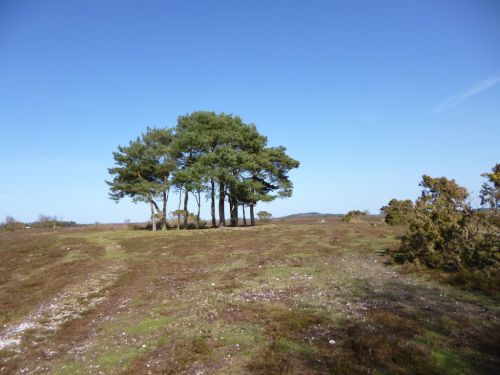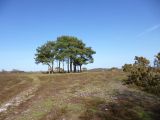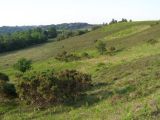Robin Hood's Butt (Furze Hill): Difference between revisions
mNo edit summary |
m (Text replacement - "* 25" map" to "* 25" O.S. map") |
||
| (8 intermediate revisions by the same user not shown) | |||
| Line 1: | Line 1: | ||
__NOTOC__{{PlaceNamesItemTop|Lat=50.894946|Lon=-1.757353|AdministrativeDivision=Hampshire|Vicinity=Ibsley Common, New Forest; near Furze Hill; ''c.'' 1 km SE of North Gorley; ''c.'' 1 km NE of South Gorley|Type=Natural feature|Interest=Robin Hood name| | __NOTOC__{{PlaceNamesItemTop|Lat=50.894946|Lon=-1.757353|AdministrativeDivision=Hampshire|Vicinity=Ibsley Common, New Forest; near Furze Hill; ''c.'' 1 km SE of North Gorley; ''c.'' 1 km NE of South Gorley|Type=Natural feature|Interest=Robin Hood name| | ||
Status=Extant|Demonym=|Riding=|GreaterLondon=|Year=1872|Aka=|Century=|Cluster1=|Cluster2=|Cluster3=|Image=geograph-2877971-by-Mike-Faherty.jpg|Postcards=|ExtraCat1=Places named Robin Hood's Butts|ExtraCat2=|ExtraCat3=|ExtraCat4=|ExtraCat5=|ExtraLink1=|ExtraLink2=|ExtraLink3=|ExtraLink4=|ExtraLink5=|ExtraLinkName1=|ExtraLinkName2=|ExtraLinkName3=|ExtraLinkName4=|ExtraLinkName5=|GeopointPrefix=|GeopointSuffix=|VicinitySuffix=|StatusSuffix=|DatePrefix=|DateSuffix=}} | Status=Extant|Demonym=|Riding=|GreaterLondon=|Year=1872|Aka=Robin Hood's Clump|Century=|Cluster1=|Cluster2=|Cluster3=|Image=geograph-2877971-by-Mike-Faherty.jpg|Postcards=|ExtraCat1=Places named Robin Hood's Butts|ExtraCat2=|ExtraCat3=|ExtraCat4=|ExtraCat5=|ExtraLink1=Robin Hood Ball (Netheravon)|ExtraLink2=|ExtraLink3=|ExtraLink4=|ExtraLink5=|ExtraLinkName1=|ExtraLinkName2=|ExtraLinkName3=|ExtraLinkName4=|ExtraLinkName5=|GeopointPrefix=|GeopointSuffix=|VicinitySuffix=|StatusSuffix=|DatePrefix=|DateSuffix=}} | ||
{{#display_map:{{#var:Coords}}~{{#replace:{{PAGENAME}}|'|'}}|width=34%|fullscreen=yes}}<div class="pnMapLegend">{{PAGENAME}}.</div> | {{#display_map:{{#var:Coords}}~{{#replace:{{PAGENAME}}|'|'}}|width=34%|fullscreen=yes}}<div class="pnMapLegend">{{PAGENAME}}.</div> | ||
[[File:{{#var:Image}}|thumb|right|500px|Robin Hood's Butt or Clump / [https://m.geograph.org.uk/photo/2877971 Mike Faherty, 1 Apr. 2012; Creative Commons, via Geograph.]]] | [[File:{{#var:Image}}|thumb|right|500px|Robin Hood's Butt or Clump / [https://m.geograph.org.uk/photo/2877971 Mike Faherty, 1 Apr. 2012; Creative Commons, via Geograph.]]] | ||
<div class="no-img"><p id="byline">By Henrik Thiil Nielsen, 2022-05-05. Revised by {{#realname:{{REVISIONUSER}}}}, {{REVISIONYEAR}}-{{REVISIONMONTH}}-{{REVISIONDAY2}}.</p> | <div class="no-img"><p id="byline">By Henrik Thiil Nielsen, 2022-05-05. Revised by {{#realname:{{REVISIONUSER}}}}, {{REVISIONYEAR}}-{{REVISIONMONTH}}-{{REVISIONDAY2}}.</p> | ||
A widely visible New Forest landmark and arguably the most prominent archaeological feature on Ibsley Common, Robin Hood's Butt or Clump on a ridge overlooking Chibden and Brogenslade Bottoms is a distinctive clump of 18 pine trees crowning a supposed Bronze Age disc barrow. The name 'Robin Hood's Butt' first appears on a 6" O.S. map of the area published in 1872. Robin Hood's Butt is a scheduled monument. | |||
The fairly small Scots pines currently making up the clump are said to have been planted in 1931 to replace previous trees destroyed by fire. The trees grow within a circular embankment whose interior is raised ''c.'' 40 cm above an outside ditch probably dug to provide materials for the earthwork. The diameter of the circular embankment is just over 10 metres and that of the ditch 15 metres. Although the earthwork is similar in form to others that are simply planting rings, according to English Heritage, Robin Hood's Butt incorporates as its base the remnants of a Bronze Age burial mound. Expert opinion is divided over this. A fact which speaks in favour of the barrow hypothesis is that the element 'butt' often occurs in the names of such monuments in the New Forest area. On the other hand it is difficult ot explain the absence of any indication of this feature from the earliest 1" O.S. map of the area which does, on the other hand, include many others on Ibsley Common which are less obvious and prominent. As clumps of trees have been planted on ancient earthworks elsewhere, it seems most likely that this was also the case with Robin Hood's Butt.<ref name="heritagerecords">[https://heritagerecords.nationaltrust.org.uk/HBSMR/MonRecord.aspx?uid=MNA180627 National Trust: Heritage Records: Robin Hood's Clump, Ibsley Common, Ibsley and Rockford Commons]</ref> | |||
< | |||
According to the 1910 allusion cited below, the tree circle at Robin Hood's Butt and others at Whitefield and Dorridge were planted by Welbore Ellis Agar (1778–1868), the second Lord Normanton,<ref>[https://en.wikipedia.org/wiki/Earl_of_Normanton Wikipedia: Earl of Normanton.]</ref> the last two in 1835, the first in 1840. According to a 1951 MS discussing this neighbourhood, it is still remembered locally 'how the Dowager Lady Normanton of Victorian times used to drive over from Somerley in her coach and pair, in the afternoons, to a view point on Furzehill where she had planted a ring of trees beneath which she sat to admire the views and distant prospect of Somerley House'.<ref name="heritagerecords"/> If, as is almost certainly the case, this refers to Robin Hood's Butt, there is clearly a conflict with the account from 1910 as to who had the tree circle planted. In the absence of arguments to the contrary, we must tentatively accept the earlier account. | |||
The National Trust's account of this locality,<ref name="heritagerecords"/> IRHB's chief source for the above, notes that the 1872 O.S. map has Robin Hood's Butt somewhat west of its true position. If the interactive map on this page is zoomed in sufficiently closely, it can be seen to have Robin Hood's Butt at what is apparently the same location as the O.S. map. While there is no evidence to suggest that the question should be answered affirmatively, it seems reasonable to ask if the name Robin Hood's Butt (or Clump) could originally have referred to some now lost feature at this more westerly location? For a Robin Hood name mistakenly transferred by modern archaeologists to a nearby feature, see [[Robin Hood Ball (Netheravon)]]. | |||
[ | |||
{{PlaceNamesItemAllusionsAndRecords}} | {{PlaceNamesItemAllusionsAndRecords}} | ||
== Gazetteers == | == Gazetteers == | ||
* Not included in {{:Dobson, Richard Barrie 1976a}}, pp. 293-311. | * Not included in {{:Dobson, Richard Barrie 1976a}}, pp. 293-311. | ||
== Sources == | == Sources == | ||
* [https:// | * [https://heritagerecords.nationaltrust.org.uk/HBSMR/MonRecord.aspx?uid=MNA180627 National Trust: Heritage Records: Robin Hood's Clump, Ibsley Common, Ibsley and Rockford Commons] | ||
* [https:// | ** [https://www.heritagegateway.org.uk/Gateway/Results_Single.aspx?uid=MNA180627&resourceID=6 Heritage Gateway: National Trust HBSMR 123290: Robin Hood's Clump, Ibsley Common, Ibsley and Rockford Commons]; same text as the preceding item. | ||
== Maps == | == Maps == | ||
* 25" map ''Hampshire and Isle of Wight'' LXII.12 (''c.'' 1875; surveyed 1870). No copy in NLS | * 25" O.S. map ''Hampshire and Isle of Wight'' LXII.12 (''c.'' 1875; surveyed 1870). No copy in NLS | ||
* [https://maps.nls.uk/geo/explore/#zoom=17&lat=50.89585&lon=-1.76117&layers=168&b=5 25" O.S. map ''Hampshire and Isle of Wight'' LXII.12 (1897; rev. 1895)] (georeferenced) | * [https://maps.nls.uk/geo/explore/#zoom=17&lat=50.89585&lon=-1.76117&layers=168&b=5 25" O.S. map ''Hampshire and Isle of Wight'' LXII.12 (1897; rev. 1895)] (georeferenced) | ||
* [https://maps.nls.uk/view/105986950#zoom=4&lat=2260&lon=10435&layers=BT 25" O.S. map ''Hampshire'' and Isle of Wight LXII.12 (1897; rev. 1895)] | * [https://maps.nls.uk/view/105986950#zoom=4&lat=2260&lon=10435&layers=BT 25" O.S. map ''Hampshire'' and Isle of Wight LXII.12 (1897; rev. 1895)] | ||
| Line 82: | Line 28: | ||
* [https://maps.nls.uk/view/101441289#zoom=5&lat=3654&lon=6724&layers=BT 6" O.S. map ''Hampshire'' & Isle of Wight LXII.SE (1910; rev. 1907).] | * [https://maps.nls.uk/view/101441289#zoom=5&lat=3654&lon=6724&layers=BT 6" O.S. map ''Hampshire'' & Isle of Wight LXII.SE (1910; rev. 1907).] | ||
== Discussion == | |||
* | * [https://richardloader.typepad.com/atwag/2007/03/clump_or_butt.html AtWaG – (All the World's a Garden): Clump or Butt?] | ||
== Background == | |||
* | * [https://www.heritagegateway.org.uk/Gateway/Results_Single.aspx?uid=217382&sort=4&search=all&criteria=new%20ditch&rational=q&recordsperpage=10&p=18&move=p&nor=399&recfc=0&resourceID=19191 Heritage Gateway: Historic England Research Records: Monument Number 217382] | ||
* [https://www.megalithic.co.uk/article.php?sid=14040 The Megalithic Portal: Ibsley Common barrows – Barrow Cemetery in England in Hampshire] | |||
* [https://en.wikipedia.org/wiki/Earl_of_Normanton Wikipedia: Earl of Normanton.] | |||
<!--== Brief mention == | <!--== Brief mention == | ||
* --> | * --> | ||
{{PlaceNamesItemAlsoSee}} | {{PlaceNamesItemAlsoSee}} | ||
== Notes == | == Notes == | ||
<references/> | <references/> | ||
Latest revision as of 16:43, 8 May 2022
| Locality | |
|---|---|
| Coordinate | 50.894946, -1.757353 |
| Adm. div. | Hampshire |
| Vicinity | Ibsley Common, New Forest; near Furze Hill; c. 1 km SE of North Gorley; c. 1 km NE of South Gorley |
| Type | Natural feature |
| Interest | Robin Hood name |
| Status | Extant |
| First Record | 1872 |
| A.k.a. | Robin Hood's Clump |

By Henrik Thiil Nielsen, 2022-05-05. Revised by Henrik Thiil Nielsen, 2022-05-08.
A widely visible New Forest landmark and arguably the most prominent archaeological feature on Ibsley Common, Robin Hood's Butt or Clump on a ridge overlooking Chibden and Brogenslade Bottoms is a distinctive clump of 18 pine trees crowning a supposed Bronze Age disc barrow. The name 'Robin Hood's Butt' first appears on a 6" O.S. map of the area published in 1872. Robin Hood's Butt is a scheduled monument.
The fairly small Scots pines currently making up the clump are said to have been planted in 1931 to replace previous trees destroyed by fire. The trees grow within a circular embankment whose interior is raised c. 40 cm above an outside ditch probably dug to provide materials for the earthwork. The diameter of the circular embankment is just over 10 metres and that of the ditch 15 metres. Although the earthwork is similar in form to others that are simply planting rings, according to English Heritage, Robin Hood's Butt incorporates as its base the remnants of a Bronze Age burial mound. Expert opinion is divided over this. A fact which speaks in favour of the barrow hypothesis is that the element 'butt' often occurs in the names of such monuments in the New Forest area. On the other hand it is difficult ot explain the absence of any indication of this feature from the earliest 1" O.S. map of the area which does, on the other hand, include many others on Ibsley Common which are less obvious and prominent. As clumps of trees have been planted on ancient earthworks elsewhere, it seems most likely that this was also the case with Robin Hood's Butt.[1]
According to the 1910 allusion cited below, the tree circle at Robin Hood's Butt and others at Whitefield and Dorridge were planted by Welbore Ellis Agar (1778–1868), the second Lord Normanton,[2] the last two in 1835, the first in 1840. According to a 1951 MS discussing this neighbourhood, it is still remembered locally 'how the Dowager Lady Normanton of Victorian times used to drive over from Somerley in her coach and pair, in the afternoons, to a view point on Furzehill where she had planted a ring of trees beneath which she sat to admire the views and distant prospect of Somerley House'.[1] If, as is almost certainly the case, this refers to Robin Hood's Butt, there is clearly a conflict with the account from 1910 as to who had the tree circle planted. In the absence of arguments to the contrary, we must tentatively accept the earlier account.
The National Trust's account of this locality,[1] IRHB's chief source for the above, notes that the 1872 O.S. map has Robin Hood's Butt somewhat west of its true position. If the interactive map on this page is zoomed in sufficiently closely, it can be seen to have Robin Hood's Butt at what is apparently the same location as the O.S. map. While there is no evidence to suggest that the question should be answered affirmatively, it seems reasonable to ask if the name Robin Hood's Butt (or Clump) could originally have referred to some now lost feature at this more westerly location? For a Robin Hood name mistakenly transferred by modern archaeologists to a nearby feature, see Robin Hood Ball (Netheravon).
Allusions
1910 - Sumner, Heywood - Book of Gorley
The three clumps of Scots fir & Weymouth pine – Whitefield[,] Robin Hood's, & Dorridge – were planted by the 2nd Lord Normanton to give landmarks & variety to his view of the long line of the New Forest Hills from Somerley – so the story is told – Whitefield & Dorridge were planted about 1835 – Robin Hood's about 1850 – Dorridge is the highest ground on the common – 257 feet above the sea level – while the lowest part is at the caltle [sic, for 'cattle'] stop, where the Huckles brook leaves the common – 100 feet above the sea level.[3]
Gazetteers
- Not included in Dobson, R. B., ed.; Taylor, J., ed. Rymes of Robyn Hood: an Introduction to the English Outlaw (London, 1976), pp. 293-311.
Sources
- National Trust: Heritage Records: Robin Hood's Clump, Ibsley Common, Ibsley and Rockford Commons
- Heritage Gateway: National Trust HBSMR 123290: Robin Hood's Clump, Ibsley Common, Ibsley and Rockford Commons; same text as the preceding item.
Maps
- 25" O.S. map Hampshire and Isle of Wight LXII.12 (c. 1875; surveyed 1870). No copy in NLS
- 25" O.S. map Hampshire and Isle of Wight LXII.12 (1897; rev. 1895) (georeferenced)
- 25" O.S. map Hampshire and Isle of Wight LXII.12 (1897; rev. 1895)
- 25" O.S. map Hampshire and Isle of Wight LXII.12 (1909; rev. 1907)
- 25" O.S. map Hampshire and Isle of Wight LXII.12 (1946; rev. 1940)
- 6" O.S. map Hampshire & Isle of Wight LXII (1872; surveyed 1870–71)
- 6" O.S. map Hampshire & Isle of Wight LXII.SE (1898; rev. 1895) (georeferenced)
- 6" O.S. map Hampshire & Isle of Wight LXII.SE (1898; rev. 1895)
- 6" O.S. map Hampshire & Isle of Wight LXII.SE (1910; rev. 1907).
Discussion
Background
- Heritage Gateway: Historic England Research Records: Monument Number 217382
- The Megalithic Portal: Ibsley Common barrows – Barrow Cemetery in England in Hampshire
- Wikipedia: Earl of Normanton.
Also see
Notes
Image gallery
Click any image to display it in the lightbox, where you can navigate between images by clicking in the right or left side of the current image.
Robin Hood's Butt or Clump / Mike Faherty, 1 Apr. 2012; Creative Commons, via Geograph.
Approaching Robin Hood's Clump, Ibsley Common, New Forest / Jim Champion, 10 June 2006; Creative Commons, via Geograph.
The view from Robin Hood's Butt, New Forest / Jim Champion, 10 June 2006; Creative Commons, via Geograph.



